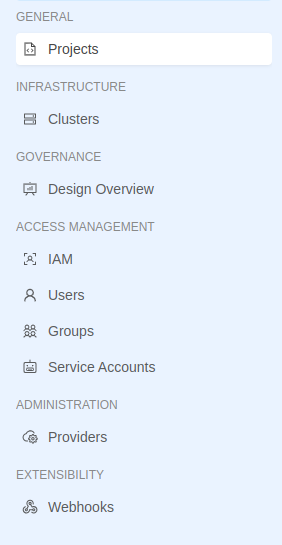Available Extension Locations
The Console allows you to embed extensions at specific locations defining the destination.id and these locations already contain menu items and groups which can also be used by our extensions. These locations are:
- Tenant with destinationId
tenant - Project with destinationId
project - Runtime with destinationId
runtime
Each location has already menu groups that can be used as category id to which attach new menu item with your extension.
Tenant

This location is found on sections related to the Company on the URLs with prefix /tenants/:tenantId that represent the location path. As visible from the image, the sidebar already contains menu groups that can be used via categoryId:
- GENERAL GROUP (categoryId:
general) - INFRASTRUCTURE GROUP (categoryId:
infrastructure) - GOVERNANCE GROUP (categoryId:
governance) - ACCESS MANAGEMENT GROUP (categoryId:
access-management) - ADMINISTRATION GROUP (categoryId:
administration) - EXTENSIBILITY GROUP (categoryId:
extensibility)
Project

This location is found on sections related to the Project overview on the URLs with prefix /projects/:projectId that represent the location path. As visible from the image, the sidebar already contains menu groups that can be used via categoryId:
- GENERAL GROUP (categoryId:
general) - ADMINISTRATION GROUP (categoryId:
administration) - RUNTIME GROUP (categoryId:
runtime) - ACCESS MANAGEMENT GROUP (categoryId:
access-management)
Runtime

This location is found on the Runtime section of a Project on the URLs with prefix /projects/:projectId/monitoring/environments/:envId that represent the location path. As visible from the image, the sidebar already contains menu groups that can be used via categoryId:
- WORKLOADS GROUP (categoryId:
workloads)
Extensions routes placed in a specific location are visible only if the extension is activated in a context that includes that location. For this reason, an extension activated on the Project context cannot be seen if its routes are located on the Tenant location.
Parametrized iframe entry
Depending on the different locations where our extension is placed, the Console can interpolate specific parameters present on its entry, allowing you to customize your iframe based on the context in which it is inserted:
- Tenant resolves the
tenantIdparameter - Project resolves the
tenantIdandprojectIdparameters - Runtime resolves the
tenantId,projectId, andenvironmentIdparameters
Each extension can register a parameterized entry by inserting parameters in its string in the form of {parameterName} and these parameters will be resolved by the Console before fetching the iframe.
Example
Consider an extension that:
- is registered on the
Projectlocation and uses a parameterized entryhttps://iframe-domain/any-path?tenant={tenantId}&project={projectId} - is active on the project with the ID
my-project-idlocated in the tenant with the IDmy-tenant-id
The Console displays the extension as soon as you enter the my-project-id project. When accessing its menu item on the sidebar, the parameterized entry is resolved and the website to be mounted in the iframe is retrieved at the URL address https://iframe-domain/any-path?tenant=my-tenant-id&project=my-project-id.
The {tenantId}, {projectId} and {environmentId} parameters can be used in any the entry URL, so you can use them in the host, path, query string or anchor based on your webapplication needs.